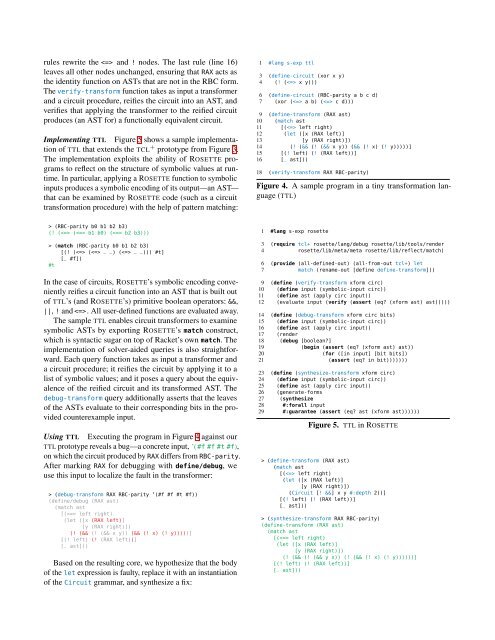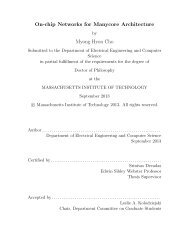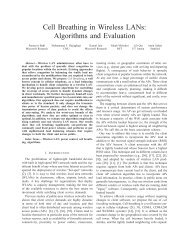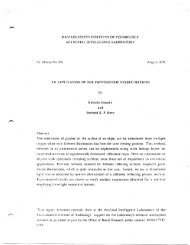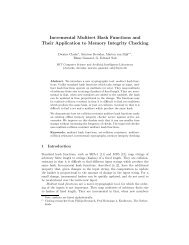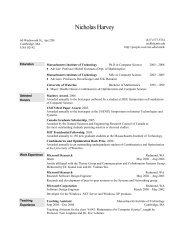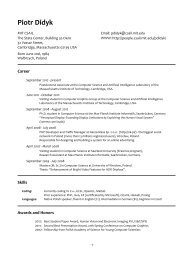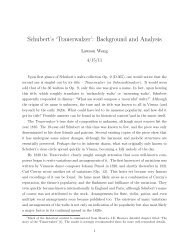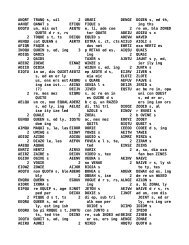Growing Solver-Aided Languages with ROSETTE - People - MIT
Growing Solver-Aided Languages with ROSETTE - People - MIT
Growing Solver-Aided Languages with ROSETTE - People - MIT
You also want an ePaper? Increase the reach of your titles
YUMPU automatically turns print PDFs into web optimized ePapers that Google loves.
ules rewrite the and ! nodes. The last rule (line 16)<br />
leaves all other nodes unchanged, ensuring that RAX acts as<br />
the identity function on ASTs that are not in the RBC form.<br />
The verify-transform function takes as input a transformer<br />
and a circuit procedure, reifies the circuit into an AST, and<br />
verifies that applying the transformer to the reified circuit<br />
produces (an AST for) a functionally equivalent circuit.<br />
Implementing TTL Figure 5 shows a sample implementation<br />
of TTL that extends the TCL + prototype from Figure 3.<br />
The implementation exploits the ability of <strong>ROSETTE</strong> programs<br />
to reflect on the structure of symbolic values at runtime.<br />
In particular, applying a <strong>ROSETTE</strong> function to symbolic<br />
inputs produces a symbolic encoding of its output—an AST—<br />
that can be examined by <strong>ROSETTE</strong> code (such as a circuit<br />
transformation procedure) <strong>with</strong> the help of pattern matching:<br />
1 #lang s-exp ttl<br />
3 (define-circuit (xor x y)<br />
4 (! ( x y)))<br />
6 (define-circuit (RBC-parity a b c d)<br />
7 (xor ( a b) ( c d)))<br />
9 (define-transform (RAX ast)<br />
10 (match ast<br />
11 [( left right)<br />
12 (let ([x (RAX left)]<br />
13 [y (RAX right)])<br />
14 (! (&& (! (&& x y)) (&& (! x) (! y)))))]<br />
15 [(! left) (! (RAX left))]<br />
16 [_ ast]))<br />
18 (verify-transform RAX RBC-parity)<br />
Figure 4. A sample program in a tiny transformation language<br />
(TTL)<br />
> (RBC-parity b0 b1 b2 b3)<br />
(! ( ( b1 b0) ( b2 b3)))<br />
> (match (RBC-parity b0 b1 b2 b3)<br />
[(! ( ( _ _) ( _ _))) #t]<br />
[_ #f])<br />
#t<br />
In the case of circuits, <strong>ROSETTE</strong>’s symbolic encoding conveniently<br />
reifies a circuit function into an AST that is built out<br />
of TTL’s (and <strong>ROSETTE</strong>’s) primitive boolean operators: &&,<br />
||, ! and . All user-defined functions are evaluated away.<br />
The sample TTL enables circuit transformers to examine<br />
symbolic ASTs by exporting <strong>ROSETTE</strong>’s match construct,<br />
which is syntactic sugar on top of Racket’s own match. The<br />
implementation of solver-aided queries is also straightforward.<br />
Each query function takes as input a transformer and<br />
a circuit procedure; it reifies the circuit by applying it to a<br />
list of symbolic values; and it poses a query about the equivalence<br />
of the reified circuit and its transformed AST. The<br />
debug-transform query additionally asserts that the leaves<br />
of the ASTs evaluate to their corresponding bits in the provided<br />
counterexample input.<br />
Using TTL Executing the program in Figure 4 against our<br />
TTL prototype reveals a bug—a concrete input, ’( #f #f #t #f),<br />
on which the circuit produced by RAX differs from RBC-parity.<br />
After marking RAX for debugging <strong>with</strong> define/debug, we<br />
use this input to localize the fault in the transformer:<br />
> (debug-transform RAX RBC-parity ’(#f #f #t #f))<br />
(define/debug (RAX ast)<br />
(match ast<br />
[( left right)<br />
(let ([x (RAX left)]<br />
[y (RAX right)])<br />
(! (&& (! (&& x y)) (&& (! x) (! y)))))]<br />
[(! left) (! (RAX left))]<br />
[_ ast]))<br />
Based on the resulting core, we hypothesize that the body<br />
of the let expression is faulty, replace it <strong>with</strong> an instantiation<br />
of the Circuit grammar, and synthesize a fix:<br />
1 #lang s-exp rosette<br />
3 (require tcl+ rosette/lang/debug rosette/lib/tools/render<br />
4 rosette/lib/meta/meta rosette/lib/reflect/match)<br />
6 (provide (all-defined-out) (all-from-out tcl+) let<br />
7 match (rename-out [define define-transform]))<br />
9 (define (verify-transform xform circ)<br />
10 (define input (symbolic-input circ))<br />
11 (define ast (apply circ input))<br />
12 (evaluate input (verify (assert (eq? (xform ast) ast)))))<br />
14 (define (debug-transform xform circ bits)<br />
15 (define input (symbolic-input circ))<br />
16 (define ast (apply circ input))<br />
17 (render<br />
18 (debug [boolean?]<br />
19 (begin (assert (eq? (xform ast) ast))<br />
20 (for ([in input] [bit bits])<br />
21 (assert (eq? in bit)))))))<br />
23 (define (synthesize-transform xform circ)<br />
24 (define input (symbolic-input circ))<br />
25 (define ast (apply circ input))<br />
26 (generate-forms<br />
27 (synthesize<br />
28 #:forall input<br />
29 #:guarantee (assert (eq? ast (xform ast))))))<br />
Figure 5. TTL in <strong>ROSETTE</strong><br />
> (define-transform (RAX ast)<br />
(match ast<br />
[( left right)<br />
(let ([x (RAX left)]<br />
[y (RAX right)])<br />
(Circuit [! &&] x y #:depth 2))]<br />
[(! left) (! (RAX left))]<br />
[_ ast]))<br />
> (synthesize-transform RAX RBC-parity)<br />
(define-transform (RAX ast)<br />
(match ast<br />
[( left right)<br />
(let ([x (RAX left)]<br />
[y (RAX right)])<br />
(! (&& (! (&& y x)) (! (&& (! x) (! y))))))]<br />
[(! left) (! (RAX left))]<br />
[_ ast]))


